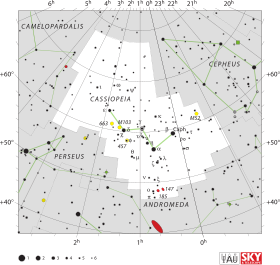NGC 637
| NGC 637 | |
 L'amas ouvert NGC 637 | |
| Données d’observation (Époque J2000.0) | |
|---|---|
| Constellation | Cassiopée |
| Ascension droite (α) | 01h 43m 03,1s[1] |
| Déclinaison (δ) | 64° 02′ 12″ [1] |
| Magnitude apparente (V) | 8,2[2] |
| Dimensions apparentes (V) | 3,0 ′[2] |
Localisation dans la constellation : Cassiopée | |
| Astrométrie | |
| Distance | environ 2 160 pc (∼7 050 al)[3] |
| Caractéristiques physiques | |
| Type d'objet | Amas ouvert |
| Classe | I3p[2] |
| Dimensions | 2,0 a.l. |
| Âge | 9,6 M a [3] |
| Découverte | |
| Découvreur(s) | William Herschel[4] |
| Date | [4] |
| Désignation(s) | OCL 329 [2] |
| Liste des amas ouverts | |
| modifier |
|
NGC 637 est un très jeune amas ouvert situé dans la constellation de Cassiopée.

NGC 637 a été découvert par l'astronome germano-britannique William Herschel en 1787.
NGC 637 est situé à environ 2 160 pc (∼7 050 al) du système solaire et les dernières estimations lui donnent un âge de 9,6 millions d'années. Le diamètre apparent de l'amas est de 3,0 minutes d'arc, soit compte tenu de la distance un diamètre réel d'environ 2,0 années-lumière.
Selon la classification des amas ouverts, NGC 637 renferme moins d'une cinquantaine d'étoiles (la lettre r) dont les magnitudes sont très différentes (le chiffre 3). La concentration d'étoile est élevée (I).
Notes et références
[modifier | modifier le code]- (en) « Results for object NGC 637 », NASA/IPAC Extragalactic Database (consulté le )
- « Les données de «Revised NGC and IC Catalog by Wolfgang Steinicke», NGC 600 à 699 », sur astrovalleyfield.ca (consulté le )
- (en) « WEBDA page for open cluster NGC 637, A site Devoted to Stellar Clusters in the Galaxy and the Magellanic Clouds » (consulté le )
- (en) Courtney Seligman, « Celestial Atlas Table of Contents, NGC 637 » (consulté le )
Voir aussi
[modifier | modifier le code]Articles connexes
[modifier | modifier le code]Liens externes
[modifier | modifier le code]- (en) NGC 637 sur la base de données NASA/IPAC Extragalactic Database
- (en) NGC 637 sur la base de données Simbad du Centre de données astronomiques de Strasbourg.
- (en) NGC 637 sur spider.seds.org
- (en) NGC 637 sur la base de données LEDA
- (en) NGC 637 sur WikiSky
- (en) NGC 637 sur le site du professeur C. Seligman
Text is available under the CC BY-SA 4.0 license; additional terms may apply.
Images, videos and audio are available under their respective licenses.

